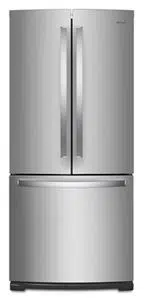Documents: Go to download!
- Owner's manual - (English, French)
- INSTALLATION INSTRUCTIONS
- REFRIGERATOR USE
- REFRIGERATOR FEATURES
- DOOR FEATURES
- REFRIGERATOR CARE
- TROUBLESHOOTING
Table of contents
USER INSTRUCTIONS REFRIGERATOR
INSTALLATION INSTRUCTIONS
Location Requirements
To ensure proper ventilation for your refrigerator, allow for a ¹⁄₂" (1.25 cm) of space on each side and at the top. Allow for a 1" (2.54 cm) space behind the refrigerator. If your refrigerator has an ice maker, allow extra space at the back for the water line connections. When installing your refrigerator next to a fixed wall, leave a 2" (5.08 cm) minimum space between the refrigerator and wall to allow the door to swing open.
NOTE: This refrigerator is intended for use in a location where the temperature ranges from a minimum of 55°F (13°C) to a maximum of 110°F (43°C). The preferred room temperature range for optimum performance, which reduces electricity usage and provides superior cooling, is between 60°F (15°C) and 90°F (32°C). It is recommended that you do not install the refrigerator near a heat source, such as an oven or radiator.

Remove and Replace Refrigerator Doors and Drawer Front
Depending on the width of your door opening, it may be necessary to remove the refrigerator doors to move the refrigerator into your home.
IMPORTANT:
- If the refrigerator was previously installed and you are moving it out of the home, before you begin, turn the refrigerator control OFF, and unplug the refrigerator or disconnect power. Remove food and any adjustable door or utility bins from doors.
- Keep the refrigerator doors closed until you are ready to lift them free from the cabinet. Provide additional support for the refrigerator door while the hinges are being removed. Do not depend on the door gasket magnets to hold the door in place while you are working.
- All graphics referenced in the following instructions are included later in this section after “Final Steps.”
TOOLS NEEDED: ⁵⁄₁₆", ³⁄₈", and ¹⁄₄" hex head socket wrenches, #2 Phillips screwdriver, and a flat-blade screwdriver.
Remove Doors and Hinges
- Unplug refrigerator or disconnect power.
- Remove the base grille. Grasp the grille firmly and pull it toward you.
- Starting with the right-hand side door, remove the parts for the top hinge as shown in Top Hinge graphic. Lift the refrigerator door from the bottom hinge pin.
- Remove the hinge pin cover from the bottom hinge pin and keep it for later use. See Bottom Hinge graphic.
- Remove top hinge cover from left-hand side refrigerator door.
- Remove the parts for the top hinge as shown in Top Hinge graphic. Lift the left-hand side door from the bottom hinge pin.
NOTE: On some models, remove the hinge pin cover from the bottom hinge pin and keep it for later use. See Bottom Hinge graphic.
Replace Doors and Hinges
1. Assemble the parts for the top hinges as shown in Top Hinge graphic. Do not tighten the screws completely.
2. Replace the parts for the bottom hinge as shown in Bottom Hinge graphic. Tighten screws. Replace the refrigerator door.
NOTE: Provide additional support for the refrigerator door while the hinges are being moved. Do not depend on the door gasket magnets to hold the door in place while you are working.
3. Align the door so that the bottom of the refrigerator doors align evenly with the top of the freezer drawer. Tighten all screws.
4. Replace the top hinge covers.
Remove and Replace Freezer Drawer Front
IMPORTANT: Two people may be required to remove and replace the freezer drawer. Graphics are included later in this section.
To remove drawer front:
- Open the freezer drawer to full extension.
- Loosen the four screws attaching the drawer glides to the drawer front. See Drawer Front Removal graphic. NOTE: Loosen screws three to four turns. Keep the screws in the drawer front.
- Lift drawer front upward and off the screws. See Drawer Front Removal graphic.
- The refrigerator leveling/roller assembly protrudes from each side of the cabinet base. Remove the three screws attaching each assembly, and remove the assemblies. See Refrigerator Leveling/Roller Assembly graphic.
To replace drawer front:
- Align the leveling/roller assembly with the holes on each side of the refrigerator cabinet. Using the screws removed, reinstall the assemblies to the cabinet base. Tighten the screws completely.
- Slide the drawer glides out of the freezer compartment. Insert the screws in the top of the drawer front into the slots in the drawer brackets. See Drawer Front Replacement graphic.
- Pull the drawer brackets toward you to position the two screws in the bottom of the drawer front into the brackets and completely tighten the four screws. See Drawer Front Replacement graphic.
- Replace the base grille.
- Pull open the freezer drawer.
- Align the three clips on the back of the base grille with the three tabs at the base of the refrigerator.
- Push the base grille in toward the refrigerator until it is firmly in place.
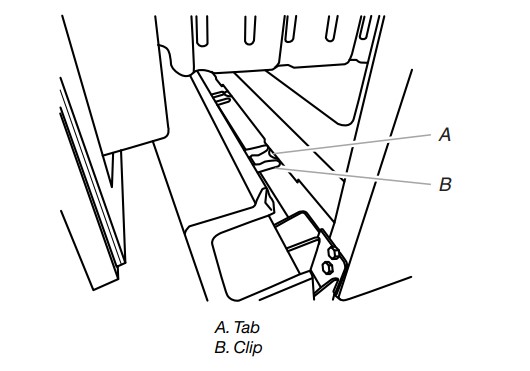
REFRIGERATOR USE
Opening and Closing Doors
There are two refrigerator compartment doors. The doors can be opened and closed either separately or together. There is a vertically-hinged seal on the left refrigerator door.
- When the left side door is opened, the hinged seal automatically folds inward so that it is out of the way.
- When both doors are closed, the hinged seal automatically forms a seal between the two doors.
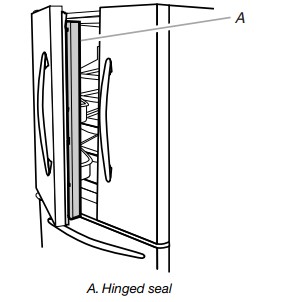
Using the Controls
Control Panel
Your refrigerator has an internal control panel, located at the top of the refrigerator compartment.
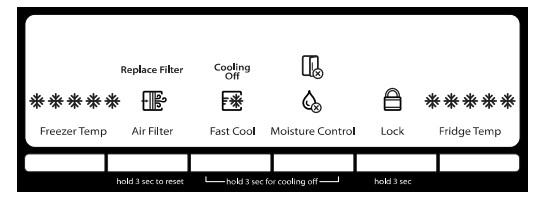
Temperature Control
For your convenience, the temperature control is preset at the factory. When you first install your refrigerator, make sure the control is still set to the recommended setting as shown.
Recommended Setting “3 Snowflakes”
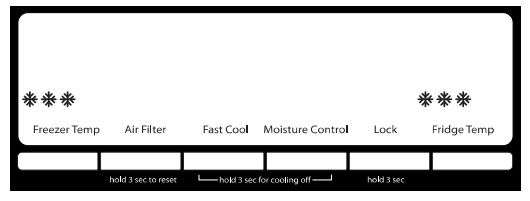
Adjusting the Controls
If you need to adjust the temperature in either the refrigerator or freezer compartment, use the settings listed in the following chart as a guide.
- Press the TEMP button to display the desired number of snowflakes from (1 snowflake [least cold] to all snowflakes [coldest])
NOTE: Except when starting the refrigerator, do not adjust the control more than one setting at a time. Wait 24 hours between adjustments for the temperature to stabilize.
| CONDITION/REASON: | ADJUSTMENT: |
|---|---|
| REFRIGERATOR too warm | FRIDGE TEMP one more snowflake |
| FREEZER too warm/too little ice | FREEZER TEMP one more snowflake |
| REFRIGERATOR too cold | FRIDGE TEMP one less snowflake |
| FREEZER too cold | FREEZER one less snowflake |
Cooling On/Off
Your refrigerator and freezer will not cool when cooling is turned off.
- To turn cooling off, press and hold both the FAST COOL and MOISTURE CONTROL buttons, at the same time, for 3 seconds. When cooling is off, the Cooling Off icon will appear on the display
- To turn cooling back on, press and hold both the FAST COOL and MOISTURE CONTROL buttons, at the same time, for 3 seconds. When cooling is on, the Cooling Off icon will disappear and the previously selected settings will be displayed.
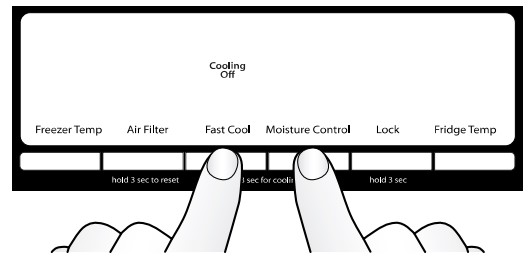
REFRIGERATOR FEATURES
Refrigerator Shelves
The shelves in your refrigerator are adjustable to match your individual storage needs.
Glass Shelves
To remove a shelf:
- Remove items from the shelf.
- Slide the shelf straight out to the stop.
- Depending on your model, lift the back or front of the shelf past the stop. Pull the shelf out the rest of the way.
To replace a shelf:
- Slide the back of the shelf into the track in the wall of the cabinet.
- Guide the front of the shelf into the shelf track. Be sure to slide the shelf in all the way

Fold Away Shelf (on some models)
To retract the fold away shelf:
■ Retract the fold away section of the shelf by holding the front of the shelf with one hand and lifting up on the center front of the shelf. Then push back and down on the shelf until it slides beneath the back section of the shelf.
To replace the fold away shelf:
■ Replace the fold away section of the shelf by holding the front of the shelf with one hand and pulling the center of the shelf until the fold away section is returned to its full shelf position.
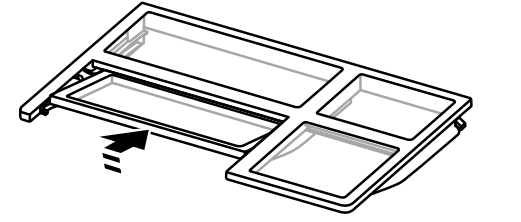
Pantry Drawer
Pantry Drawer
To remove and replace the pantry drawer:
- Slide pantry drawer out to the stop.
- Lift front of pantry drawer with one hand while supporting bottom of drawer with other hand. Slide drawer out the rest of the way.
- Replace the drawer by sliding it back in fully past the drawer stop.
Pantry Drawer Cover
To remove and replace the pantry drawer cover:
- Remove the pantry drawer.
- From underneath, push up on the glass cover and pull it out.
- Replace the pantry drawer cover by lowering it into place.
- Replace the pantry drawer.
Pantry Drawer Control
The amount of air flowing through the pantry drawer affects the temperature inside the drawer.
The airflow control is located on the left side of the pantry drawer.
To adjust the airflow:
■ Colder - Slide the control forward, toward the front of the pantry drawer. The airflow is open.
■ Cold - Slide the control all the way toward the rear of the pantry drawer. The airflow is closed, as shown.
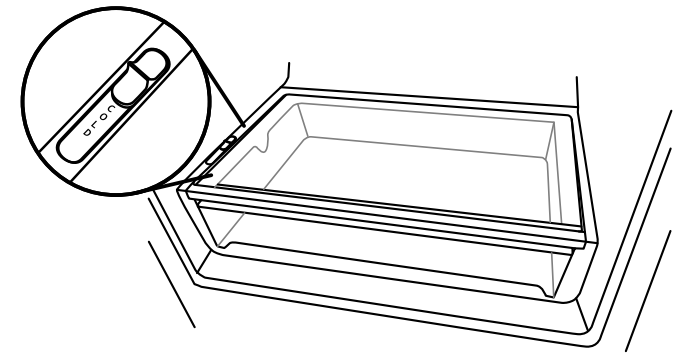
Crisper
Crisper Drawers
To remove and replace the crisper drawer:
- Slide the crisper drawer straight out to the stop. Lift the front and slide the drawer out the rest of the way.
- Replace the drawer by sliding the drawer in fully past the stop.

Crisper Cover
To remove and replace the glass crisper cover:
- Pull the glass straight out.
- Replace the glass by pushing it straight in.
Crisper Humidity Control (on some models)
You can control the amount of humidity in the moisture-sealed crisper. Adjust the control to any setting between LOW and HIGH. LOW (open) lets moist air out of the crisper for best storage of fruits and vegetables with skins.
■ Fruit: Wash, let dry and store in refrigerator in plastic bag or crisper. Do not wash or hull berries until they are ready to use. Sort and keep berries in original container in crisper, or store in a loosely closed paper bag on a refrigerator shelf.
■ Vegetables with skins: Place in plastic bag or plastic container and store in crisper.
HIGH (closed) keeps moist air in the crisper for best storage of fresh, leafy vegetables.
■ Leafy vegetables: Wash in cold water, drain and trim or tear off bruised and discolored areas. Place in plastic bag or plastic container and store in crisper.

DOOR FEATURES
Condiment Bins
To remove and replace the condiment bins:
- Tilt the bin by grabbing it and pulling outward.
- Remove the bin by grabbing it and lifting it upward off the glides.
- Replace the bin by sliding it back onto the glides and then push it closed.
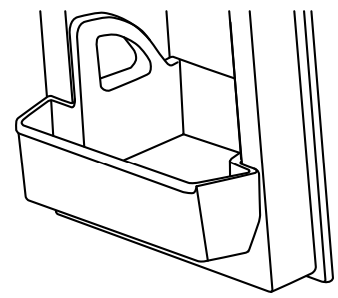
Fresh Bin (on some models)
To remove and replace the fresh bin:
- Open the bin by grabbing the top center lip of the bin and tilting the bin outward.
- Remove the bin by grabbing both sides of the bin and lifting the bin upward off the glides.
- Replace the bin by sliding it back into its tilted position on the glides and then push it closed.
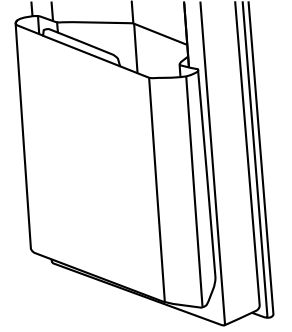
Half-Height Bin (on some models)
To remove and replace the half-height bin:
- Tilt the bin by grabbing it and pulling outward.
- Remove the bin by grabbing it and lifting it upward off the glides.
- Replace the bin by sliding it back onto the glides and then push it closed.

REFRIGERATOR CARE
Cleaning
Both the refrigerator and freezer sections defrost automatically. However, clean both sections about once a month to avoid buildup of odors. Wipe up spills immediately
IMPORTANT:
- Because air circulates between both sections, any odors formed in one section will transfer to the other. You must thoroughly clean both sections to eliminate odors. To avoid odor transfer and drying out of food, wrap or cover foods tightly.
- For stainless steel models, stainless steel is corrosion-resistant and not corrosion-proof. To help avoid corrosion of your stainless steel, keep your surfaces clean by using the following cleaning instructions.
To Clean Your Refrigerator:
NOTE: Do not use abrasive or harsh cleaners such as window sprays, scouring cleansers, flammable fluids, muriatic acid, cleaning waxes, concentrated detergents, bleaches or cleansers containing petroleum products on exterior surfaces (doors and cabinet), plastic parts, interior and door liners or gaskets. Do not use paper towels, scouring pads, or other harsh cleaning tools.
1. Unplug refrigerator or disconnect power.
2. Hand wash, rinse, and dry removable parts and interior surfaces thoroughly. Use a clean sponge or soft cloth and a mild detergent in warm water.
3. Clean the exterior surfaces.
Painted metal: Wash painted metal exteriors with a clean, soft cloth or sponge and a mild detergent in warm water. Rinse surfaces with clean, warm water and dry immediately to avoid water spots.
Stainless steel: Wash stainless steel surfaces with a clean, soft cloth or sponge and a mild detergent in warm water. Rinse surfaces with clean, warm water and dry immediately to avoid water spots.
NOTE: When cleaning stainless steel, always wipe in the direction of the grain to avoid cross-grain scratching.
4. There is no need for routine condenser cleaning in normal home operating environments. If the environment is particularly greasy or dusty, or there is significant pet traffic in the home, the condenser should be cleaned every 2 to 3 months to ensure maximum efficiency.
If you need to clean the condenser:
- Remove the base grille.
- Use a vacuum cleaner with a soft brush to clean the grille, the open areas behind the grille and the front surface area of the condenser.
- Replace the base grille when finished.
5. Plug in refrigerator or reconnect power.
Changing the Light Bulbs
IMPORTANT:
- Not all appliance bulbs will fit your refrigerator. Be sure to replace the bulb with an appliance bulb of the same size, shape and wattage.
- To ensure optimum refrigerator performance, replace light bulbs as soon as they burn out.
Freezer Compartment Light (on some models)
1. Unplug the refrigerator or disconnect power.
2. Remove the light shield (on some models).
- Top of the freezer compartment - Slide the light shield toward the back of the compartment to release it from the light assembly.
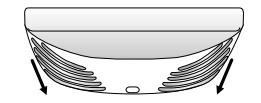
3. Replace the burned-out bulb with an appliance bulb(s) no greater than 25 watts.
4. Replace the light shield.
5. Plug in refrigerator or reconnect power.
TROUBLESHOOTING
Operation
| PROBLEM | POSSIBLE CAUSES | SOLUTIONS |
|---|---|---|
| The refrigerator will not operate | Check electrical supply | Plug the power cord into a grounded 3 prong outlet. |
| Do not use an extension cord. | ||
| Make sure there is power to the outlet. Plug in a lamp to see if the outlet is working. | ||
Reset a tripped circuit breaker. Replace any blown fuses. NOTE: If problems continue, contact an electrician. | ||
| Check controls | Make sure cooling is turned on. See “Using the Controls.” | |
| New installation | Allow 24 hours following installation for the refrigerator to cool completely. NOTE: Adjusting the temperature controls to the coldest setting will not cool either compartment quicker. | |
| The motor seems to run too much | High efficiency compressor and fans | This is normal. Larger, more efficient refrigerators run longer. |
| The room or outdoor temperature is hot | It is normal for the refrigerator to work longer under these conditions. For optimum performance, place the refrigerator in an indoor, temperature controlled environment. See “Location Requirements.” | |
| A large amount of warm food has been recently added | Warm food will cause the refrigerator to run longer until the air cools to the desired temperature. | |
| The door(s) are opened too frequently or for too long | Warm air entering the refrigerator causes it to run more. Open the door less often. | |
| The refrigerator door or freezer drawer is ajar | Make sure the refrigerator is level. See “Door Closing and Door Alignment.” Keep food and containers from blocking the door. | |
| The refrigerator control is set too cold | Adjust the refrigerator control to a less cold setting until the refrigerator temperature is as desired. See “Using the Controls.” | |
| The door or drawer gasket is dirty, worn or cracked | Clean or change the gasket. Leaks in the door seal will cause the refrigerator to run longer in order to maintain desired temperatures. | |
| The lights do not work | A light bulb is loose in the socket or burned out | Tighten or replace the light bulb. See “Changing the Light Bulbs.” |
Noise
| PROBLEM | POSSIBLE CAUSES | SOLUTIONS |
|---|---|---|
The refrigerator seems noisy Below are listed some normal sounds with explanations. | The refrigerator seems noisy Below are listed some normal sounds with explanations. | |
| Sound of the compressor running longer than expected | High efficiency compressor and fans | This is normal. Larger, more efficient refrigerators run longer. |
| Pulsating/Whirring | Fans/compressor adjusting to optimize performance during normal compressor operation | This is normal. |
| Popping | Contraction/expansion of inside walls, especially during initial cool-down | This is normal. |
| Hissing/Dripping | Flow of refrigerant, or flow of oil in the compressor | This is normal. |
| Vibration | The refrigerator may not be steady | Adjust the leveling screws and lower the leveling foot firmly against the floor. See “Door Closing and Door Alignment.” |
| Rattling/Banging | Movement of the water lines against the refrigerator cabinet, or of items placed on top of the refrigerator cabinet | Move excess water line away from the refrigerator cabinet or fasten excess tubing to the cabinet. See “Connecting the Water,” or remove items from the top of the refrigerator. |
| Sizzling | Water dripping on the heater during defrost cycle | This is normal. |
| Water running/Gurgling | May be heard when ice melts during the defrost cycle and water runs into the drain pan | This is normal. |
| Buzzing | Heard when the water valve opens to fill the ice maker | This is normal. |
| Creaking/Cracking | May be heard as ice is being ejected from the ice maker mold | This is normal. |
| Ker-plunk | May be heard when the ice falls into the ice storage bin | This is normal. |
Temperature and Moisture
| PROBLEM | POSSIBLE CAUSES | SOLUTIONS |
|---|---|---|
| Temperature is too warm | The refrigerator has just been installed | Allow 24 hours following installation for the refrigerator to cool completely |
| Cooling is turned off | Turn cooling on. See “Using the Controls.” | |
| The controls are not set correctly for the surrounding conditions | Adjust the controls a setting colder. Check the temperature in 24 hours. See “Using the Control(s).” | |
| The door(s) are opened often or not closed completely | Allows warm air to enter refrigerator. Minimize door openings and keep doors fully closed. | |
| A large load of food was recently added | Allow several hours for refrigerator to return to normal temperature. | |
| Temperature is too cold in the refrigerator/crisper | The refrigerator air vent(s) are blocked | If the air vent located in the top, left, rear corner of the refrigerator compartment is blocked by items placed directly in front of it, the refrigerator will get too cold. Move items away from the air vent. |
| The controls are not set correctly for the surrounding conditions | Adjust the controls a setting warmer. Check the temperature in 24 hours. See “Using the Control(s).” | |
| The ice storage bin is not in the correct position (on some models) | Make sure the ice storage bin is positioned so that it is not blocking airflow. | |
| Temperature is too cold in the pantry drawers (on some models) | The control is not set correctly for the items stored in drawer | Adjust the control setting. See “Refrigerator Features.” |
| There is interior moisture buildup NOTE: Some moisture buildup is normal. | The room is humid | A humid environment contributes to moisture buildup. |
| The door(s) are opened often or not closed completely | Allows humid air to enter the refrigerator. Minimize door openings and close doors completely | |
| The door is blocked open | Move food packages away from door. | |
| A bin or shelf is in the way | Push bin or shelf back into the correct position. | |
| Storing liquid in open containers | This adds humidity to the refrigerator interior. Keep all containers tightly covered. | |
| There is frost/ice buildup in the freezer compartment | The doors are opened often or left open | Minimize door openings and keep doors fully closed. |
| Poor door seal | Ensure door seals are making full contact with the refrigerator cabinet to allow for an adequate seal. | |
| Temperature controls are not set correctly | See “Using the Controls” for recommended temperature settings. |
Ice and Water
| PROBLEM | POSSIBLE CAUSES | SOLUTIONS |
|---|---|---|
| The ice maker is not producing ice or is not producing enough ice (on some models) | The refrigerator is not connected to a water supply or the water supply shutoff valve is not turned on | Connect refrigerator to water supply and turn water shutoff valve fully open. |
| There is a kink in the water source line | A kink in the line can reduce water flow. Straighten the water source line. | |
| The ice maker is not turned on | Make sure the ice maker is on. | |
| The refrigerator has just been installed | Wait 24 hours after ice maker installation for ice production to begin. Wait 3 days for full ice production. | |
| The refrigerator door is not closed completely | Close the door firmly. If it does not close completely, see “The doors will not close completely.” | |
| A large amount of ice was recently removed | Allow 24 hours for ice maker to produce more ice. | |
| An ice cube is jammed in the ice maker ejector arm | Remove ice from the ejector arm with a plastic utensil. NOTE: On some models, press the lever which opens the ice maker door to access the ejector arm. | |
| A reverse osmosis water filtration system is connected to your cold water supply | This can decrease water pressure. See “Water Supply Requirements. | |
The ice cubes are hollow or small (on some models) NOTE: This is an indication of low water pressure. | The water shutoff valve is not fully open | Turn the water shutoff valve fully open. |
| There is a kink in the water source line | A kink in the line can reduce water flow. Straighten the water source line. | |
| A reverse osmosis water filtration system is connected to your cold water supply | This can decrease water pressure. See “Water Supply Requirements.” | |
| Questions remain regarding water pressure | Call a licensed, qualified plumber. | |
| Off-taste, odor or gray color in the ice (on some models) | Recently installed or replaced plumbing connections (new plumbing connections can cause discolored or off-flavored ice and water.) | Discard the ice and wash the ice storage bin. Allow 24 hours for the ice maker to make new ice, and discard the first 3 batches of ice produced. |
| The ice has been stored too long | Discard ice. Wash ice storage bin. Allow 24 hours for ice maker to make new ice. | |
| Odor from stored food has transferred to the ice | Use airtight, moisture proof packaging to store food. | |
| There are minerals (such as sulfur) in the water | A water filter may need to be installed to remove the minerals. | |
| Water is leaking from the back of the refrigerator | The water line connections were not fully tightened | See “Connecting the Water.” |
| Recently removed the doors and did not fully tighten water line connection | See “Remove and Replace Refrigerator Doors and Freezer Drawer Front.” |
Doors
| PROBLEM | POSSIBLE CAUSES | SOLUTIONS |
|---|---|---|
| The door(s) or drawer will not close completely | The door or drawer is blocked open | Move food packages away from door(s). Remove ice or other items which have fallen onto the floor of the freezer compartment. |
| A bin or shelf is in the way | Push bin or shelf back into the correct position. | |
| Recently installed | Remove all packaging materials. | |
| The doors are difficult to open | The door gaskets are dirty or sticky. | Clean gaskets and contact surfaces with mild soap and warm water. Rinse and dry with soft cloth. |
| The doors appear to be uneven | The doors need to be aligned or the refrigerator needs to be leveled | See “Door Closing and Door Alignment.” |
| The doors do not open or close as expected | The refrigerator tilt needs to be adjusted | Adjust the refrigerator tilt. See “Door Closing and Door Alignment.” |
See other models: WP1000P WRF767SDEM WRS325SDHZ YWFE775H0HB WRX735SDHV
